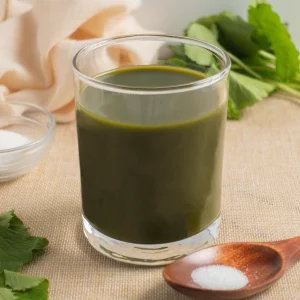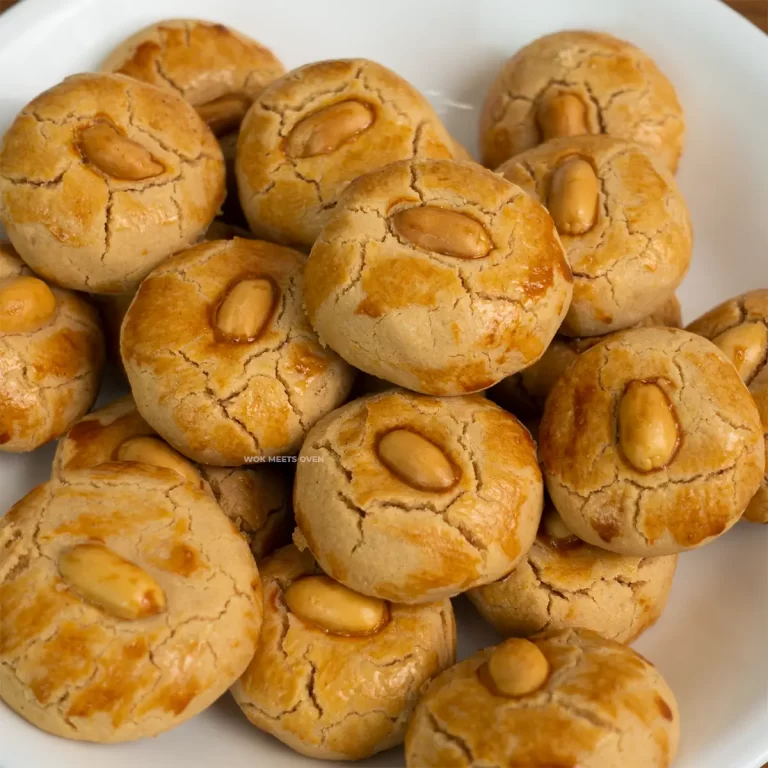The Chinese Steamed Egg Recipe You’ll Want to Make Again and Again!
Soft, silky smooth eggs in every bite. This 20-minute Chinese steamed eggs recipe is easy, delicious, and packs a whole lot of flavor with only a few simple ingredients!
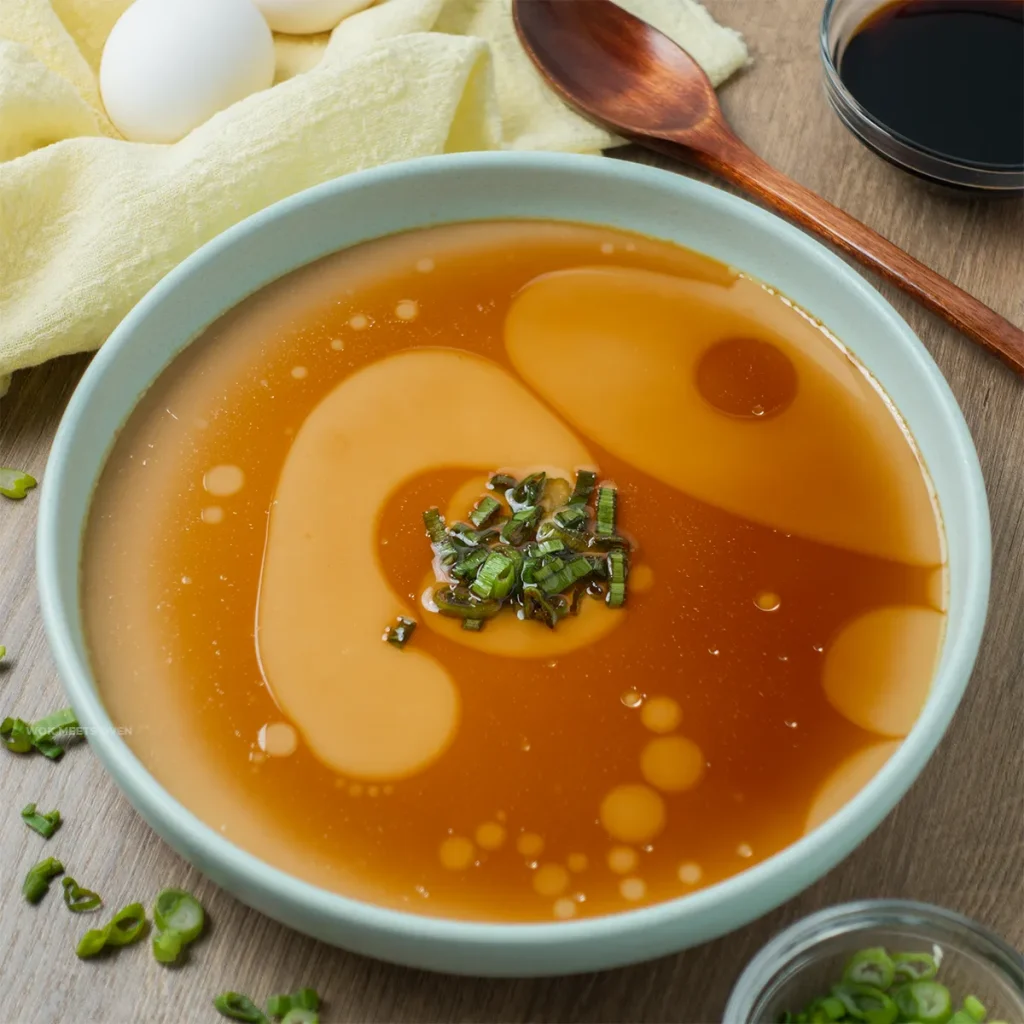
What Are Chinese Steamed Eggs
Chinese steamed eggs or Chinese-style steamed eggs (蒸水蛋 in Cantonese) is a popular Chinese dish that involves combining beaten eggs with water and steaming the eggs to create perfectly smooth and silky eggs with the texture of silken tofu.
The eggs are typically drizzled with some soy sauce or sesame oil to further add flavor to the eggs. And in some cases, additional toppings such as ground pork or some sort of protein are added to the eggs. This Asian steamed egg recipe might seem like a simple recipe using a few simple ingredients, but it is hard to master if you don’t know the proper technique.
Funny enough, a lot of Chinese dishes are like that; they may look simple to make on the outside, but hard to execute properly.
To get that perfect steamed egg consistency and texture, you’ll need to master a few things:
- The type of water used to cook the eggs with
- The ratio of eggs to water
- Whether or not your eggs are sieved
- The type of bowl or plate you use to steam the eggs
- The temperature you use to steam the eggs
- How long do you steam the eggs for
As you can see here, it’s not quite as simple as most people would think to get the perfect steamed eggs.
Luckily, though, I’m going to share with you my technique for getting those perfectly steamed eggs in my Chinese steamed eggs recipe.
The Optimal Egg and Water Ratio for Chinese Steamed Eggs
I’ve found through testing that the optimal egg and water ratio is around 1:1.5. This will ensure that your eggs are very soft and silky while still remaining a little firm and allowing you to taste the eggs.
Chinese Steamed Eggs Ingredient Notes

Large eggs: The star of the show and the reason why you’re here. You can use regular, free-range, omega-3, whatever you like. I just opt for the cheapest option that is available because grocery prices continue to rise 😞
Table salt: The table salt will be added to the eggs to slightly season them so they’re not so bland.
Distilled water: Make sure you’re using distilled water or boiled water (that has cooled down) and not tap water. Using tap water will affect the texture of the eggs and make them not nearly as smooth.
Light soy sauce: Light soy sauce will be our main seasoning agent to give our steamed eggs flavor. Make sure you’re using light soy sauce and not dark soy sauce, which is used mainly to add color to a dish.
White granulated sugar: White sugar is added to the soy sauce to balance out all of the saltiness in the soy sauce.
Cooking oil: Adds an additional layer of flavor to the dish. You can use vegetable oil, canola, corn, peanut oil, etc.
Green onion: Used mainly as a garnish. The green onions will get cooked as well once you pour the hot oil on top of the eggs.
Substitutions
- Green onions: You can substitute them with some chives or Chinese garlic chives
- White granulated sugar: You can use brown sugar as a substitute
- Table salt: you can use kosher, sea salt, whatever you like, even that fancy Himalayan pink salt that everyone seems to be using nowadays (actually, I don’t know if Himalayan pink salt would work as I don’t own any at home 🤔, use at your own risk!)
- Distilled water: You can substitute it with some chicken broth for a little extra flavor if you’d like. You can also use boiled water that has cooled down to room temperature as well.
Directions
- Crack 4 eggs into a bowl. Add in your table salt and then whisk the eggs until they are thoroughly mixed.
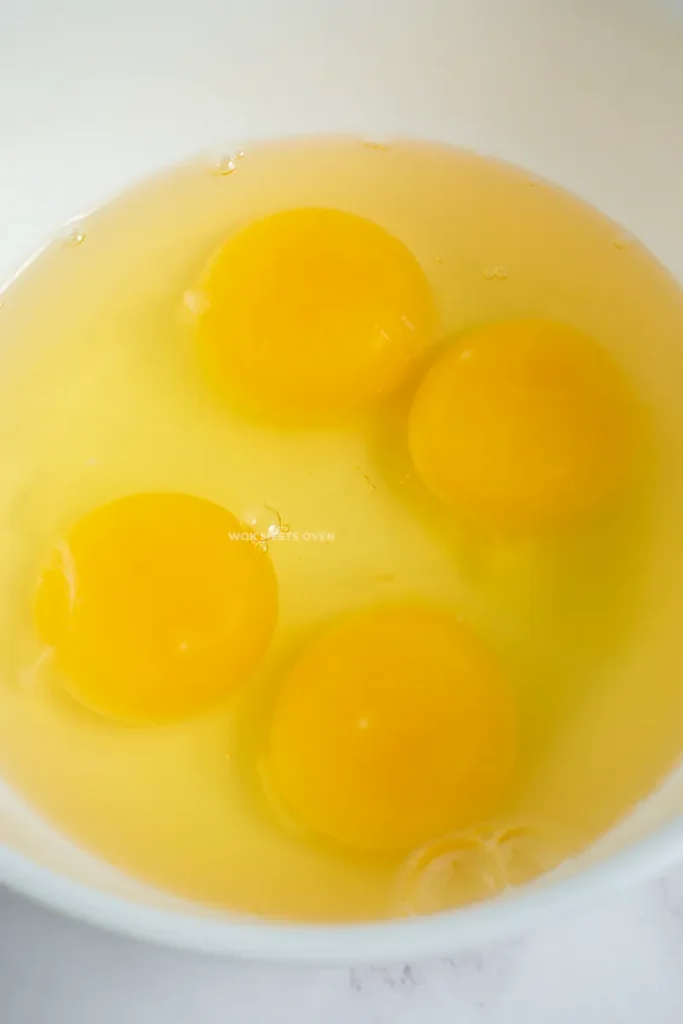
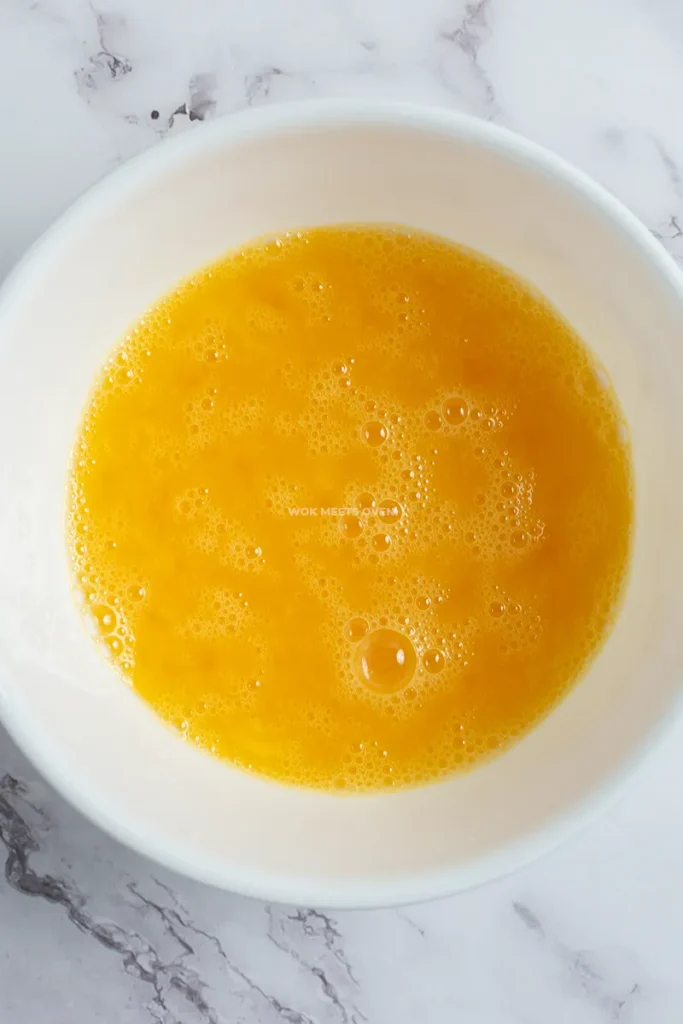
- Now add the distilled water to the eggs and mix everything well together.
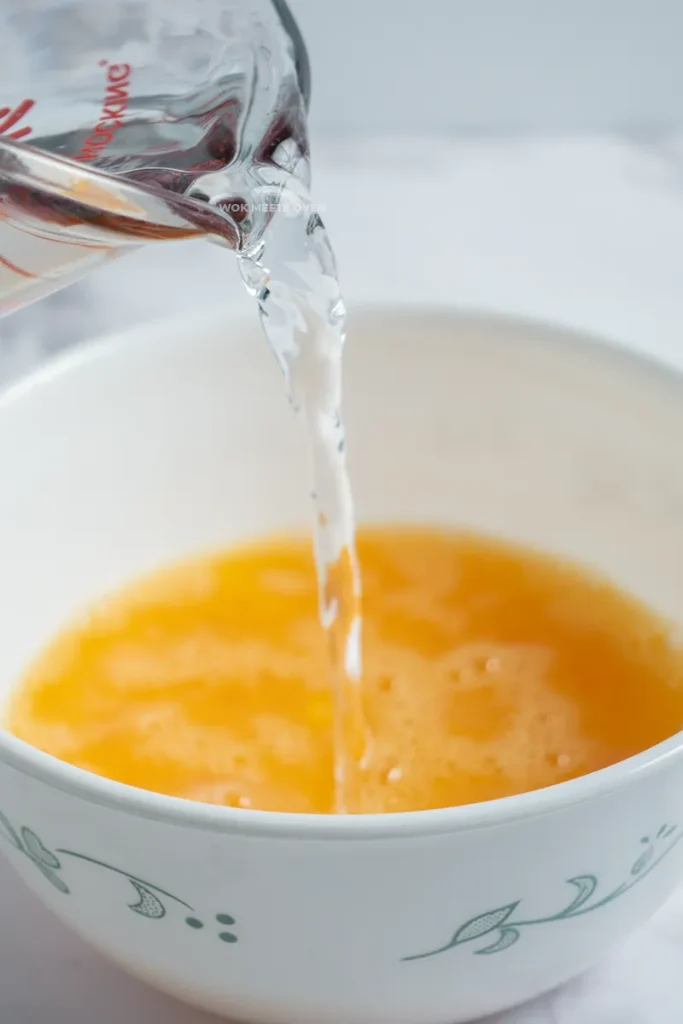
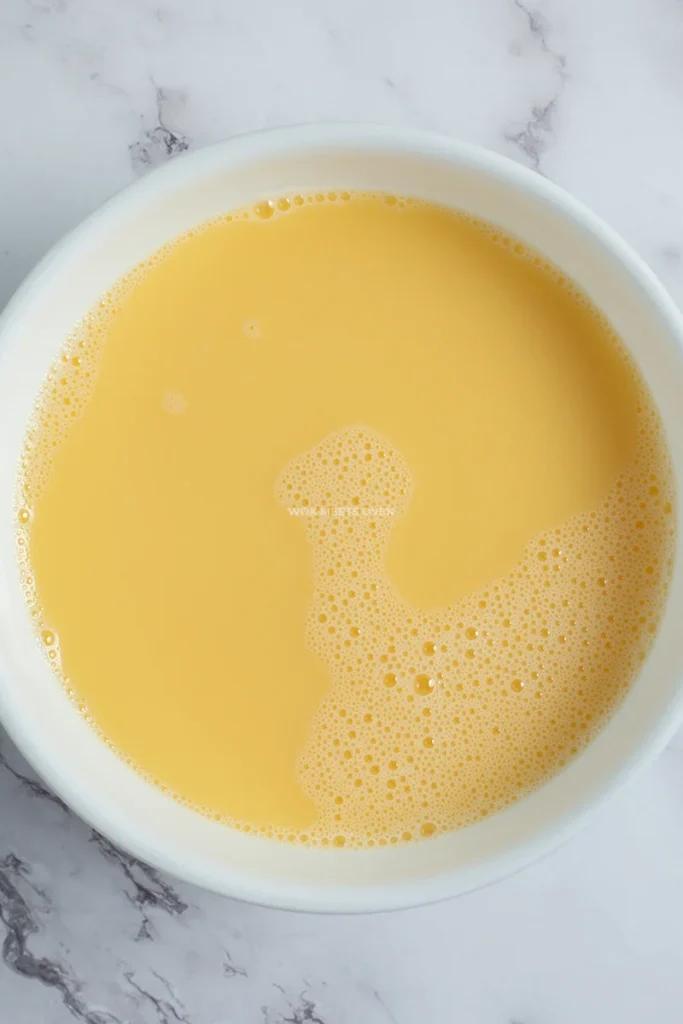
- Now, using a sieve, pour the egg water mixture into a large bowl or plate.
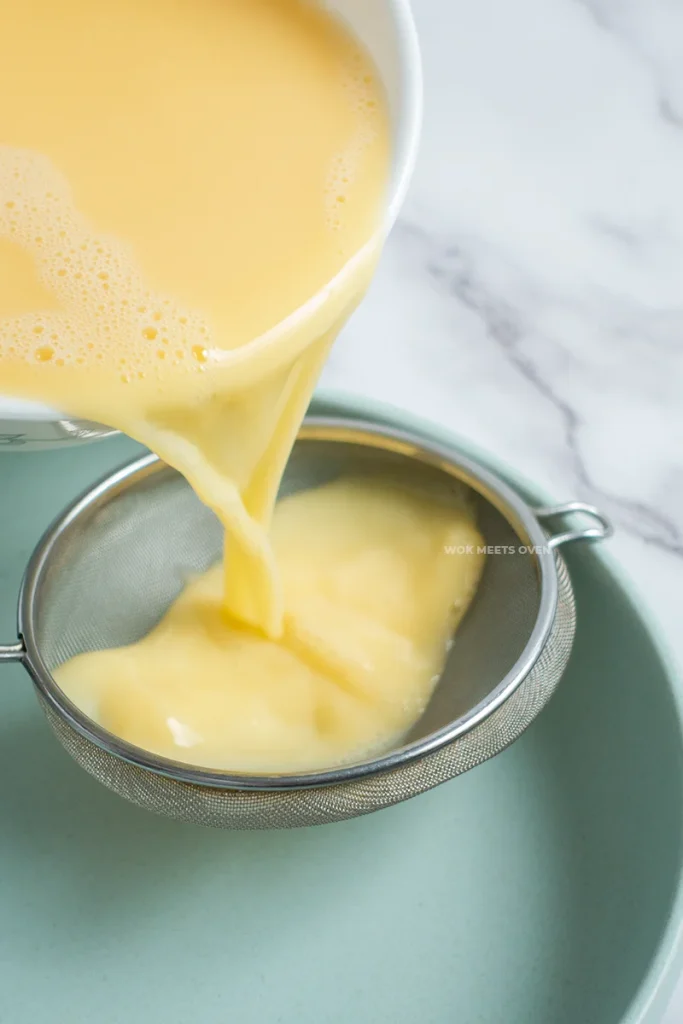

- If you see any bubbles, pop the bubbles by using either a toothpick or a lighter. You can also use a spoon to scoop out the bubbles. If you don’t pop the bubbles, then the surface of the eggs won’t look nearly as smooth.
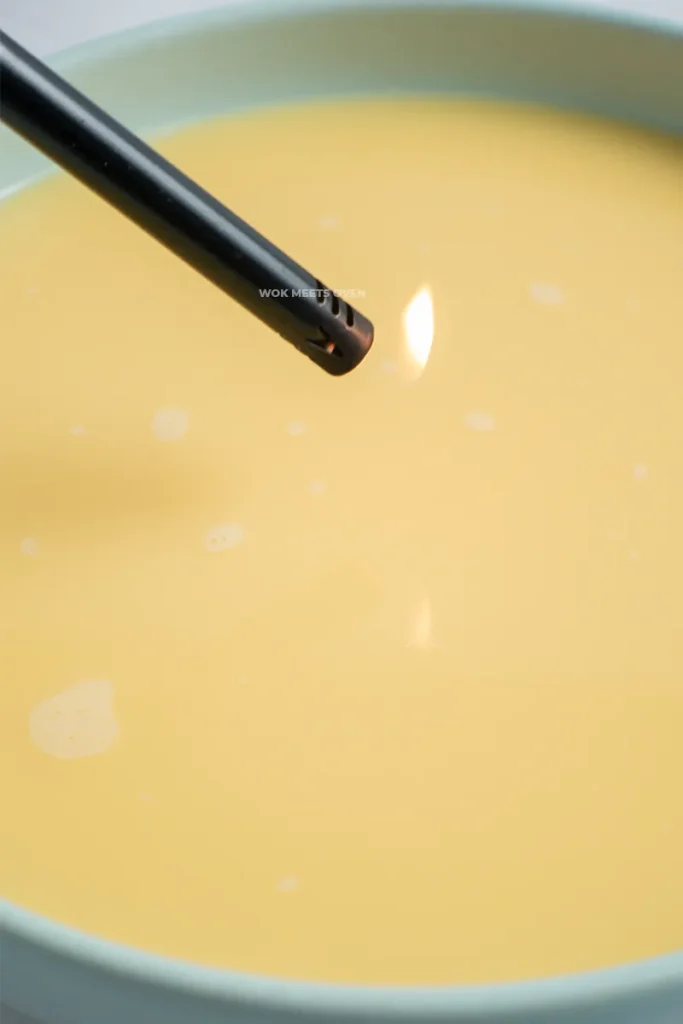
- Next, cover the bowl or plate with some heat-resistant plastic wrap. Poke a few holes in the plastic wrap to let steam escape while steaming the eggs.
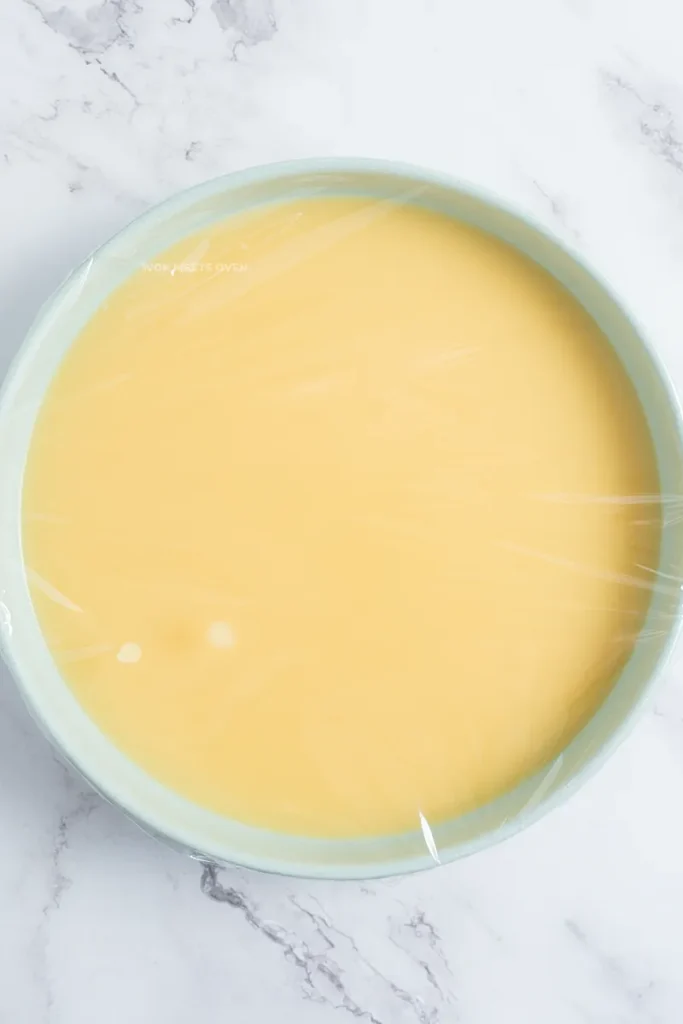
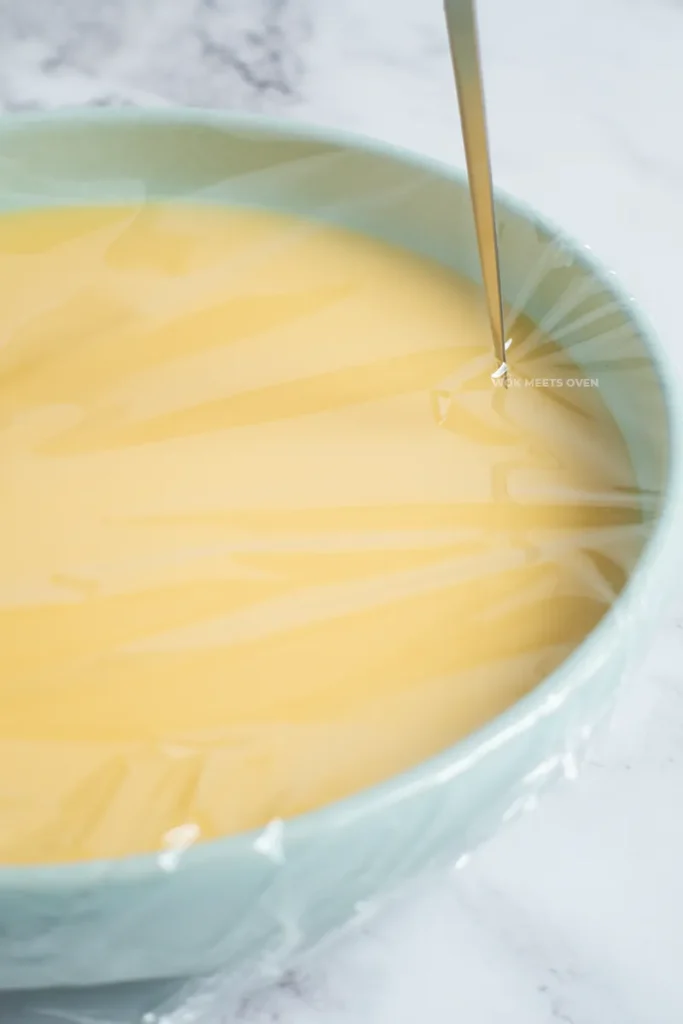
- Now add your eggs into a steamer or use a wok with a hot pot stand. Add some water to the wok or steamer and cover it with a lid, and bring it to a boil on medium heat.

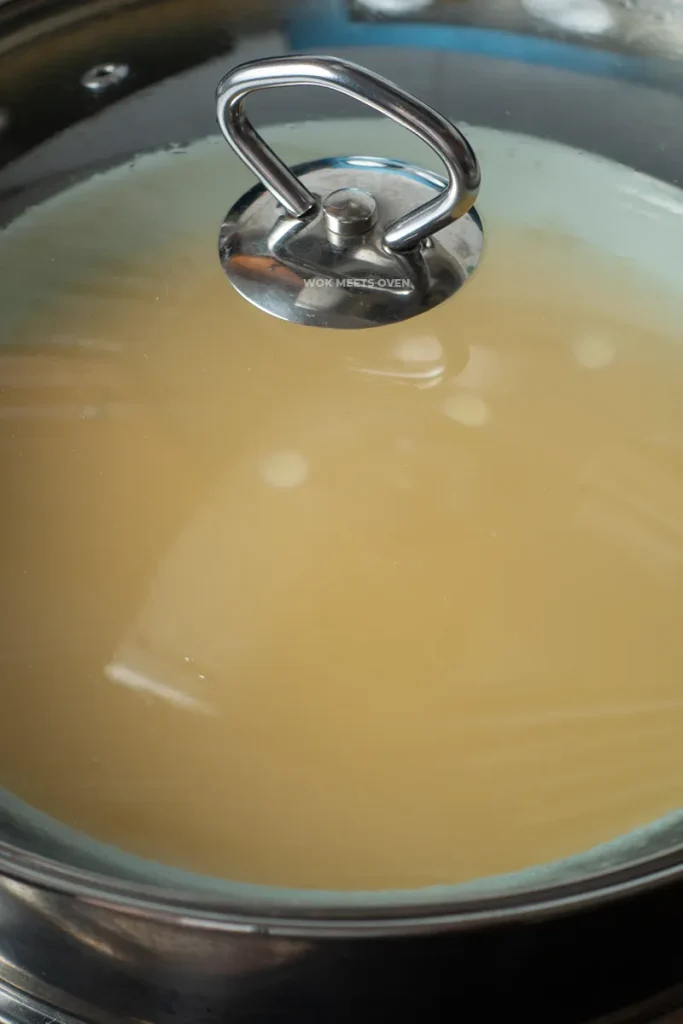
- Once the water starts to boil, reduce the heat to medium-low and steam it for 13-14 minutes.
- While your eggs are steaming, prepare the soy sauce.
- In a small saucepan, add in your light soy sauce and sugar and mix everything well together. Heat up the saucepan until the sugar is melted, and then set it aside.
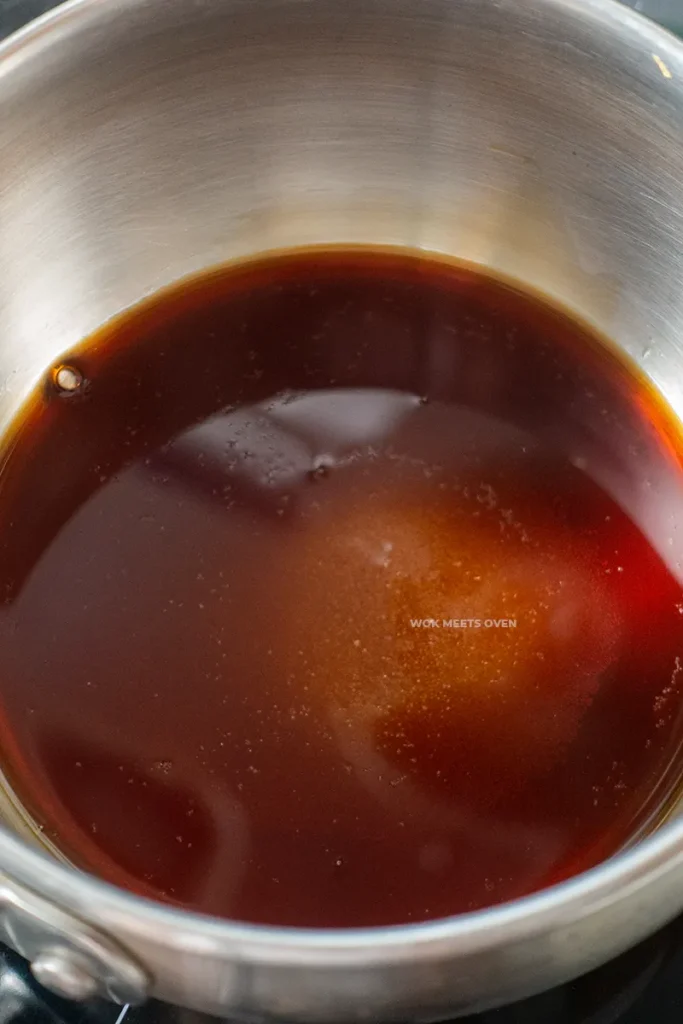
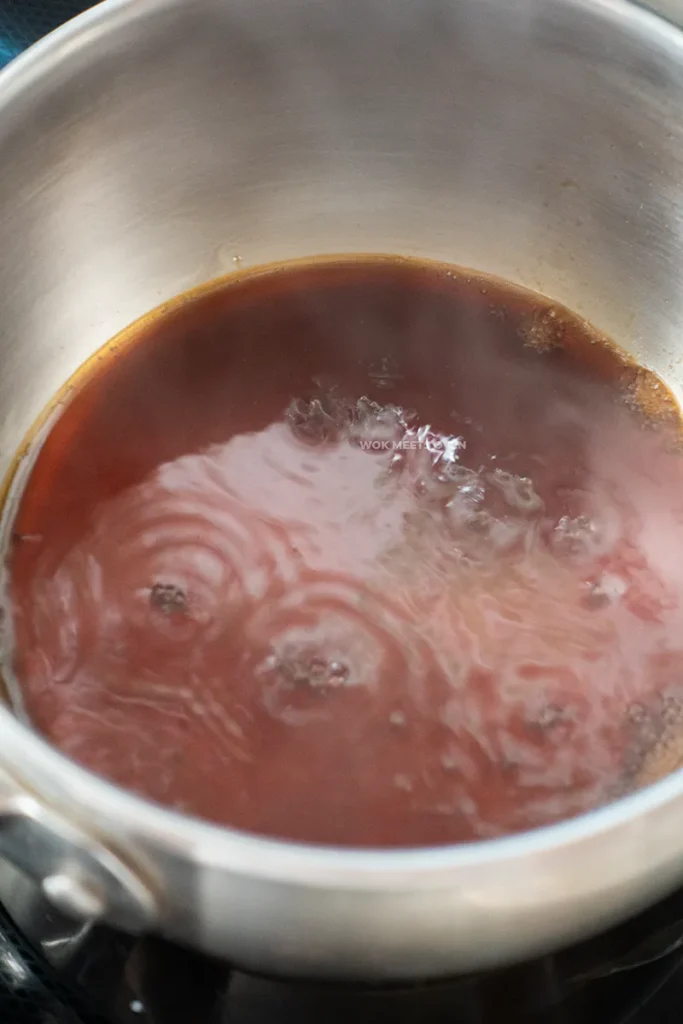
- Once 13-14 minutes have passed, turn off the stove but leave the eggs in the steamer or wok for another 5 minutes. Don’t open the lid!
- Finally, remove the eggs from the steamer after 5 minutes. Pour the soy sauce on top.
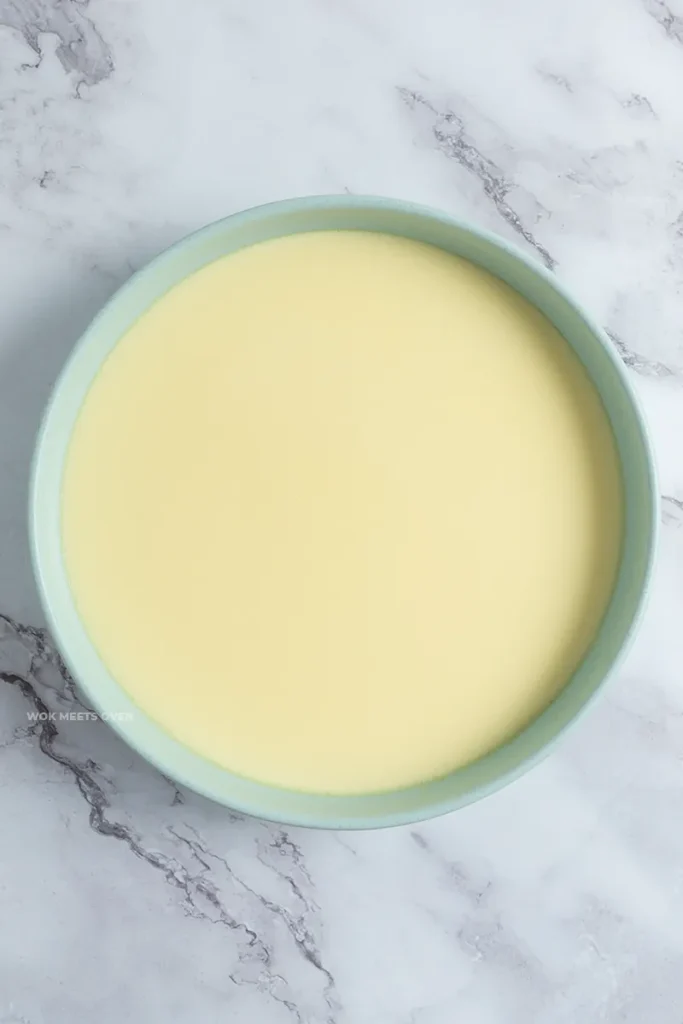
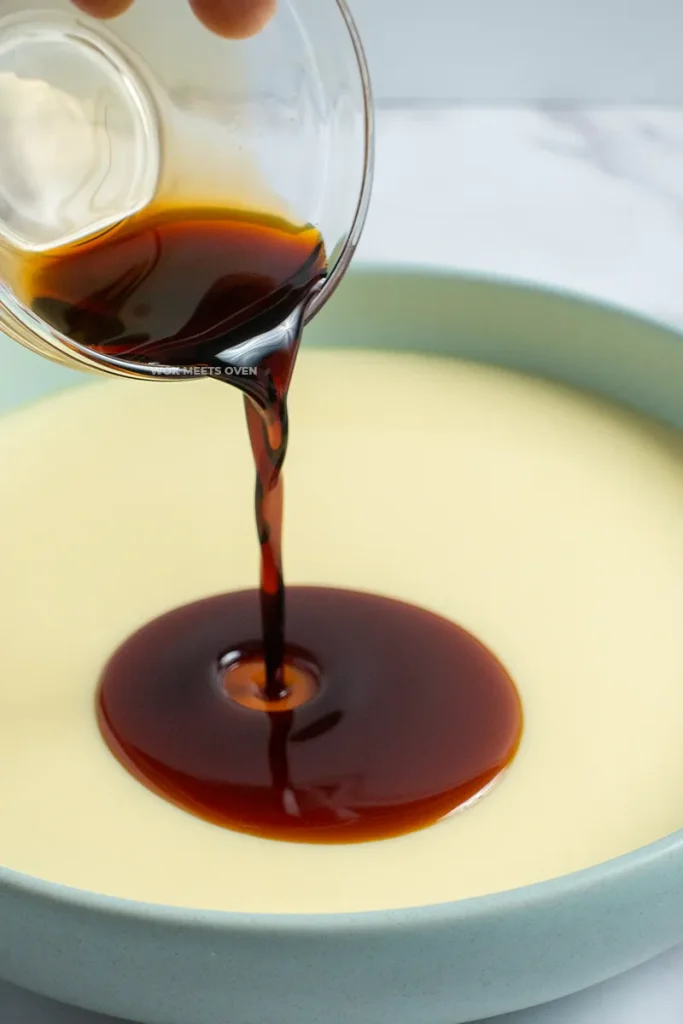
- Garnish the eggs with some green onions. Now heat up some cooking oil until it’s hot and then pour it on top of the eggs and green onions and serve.

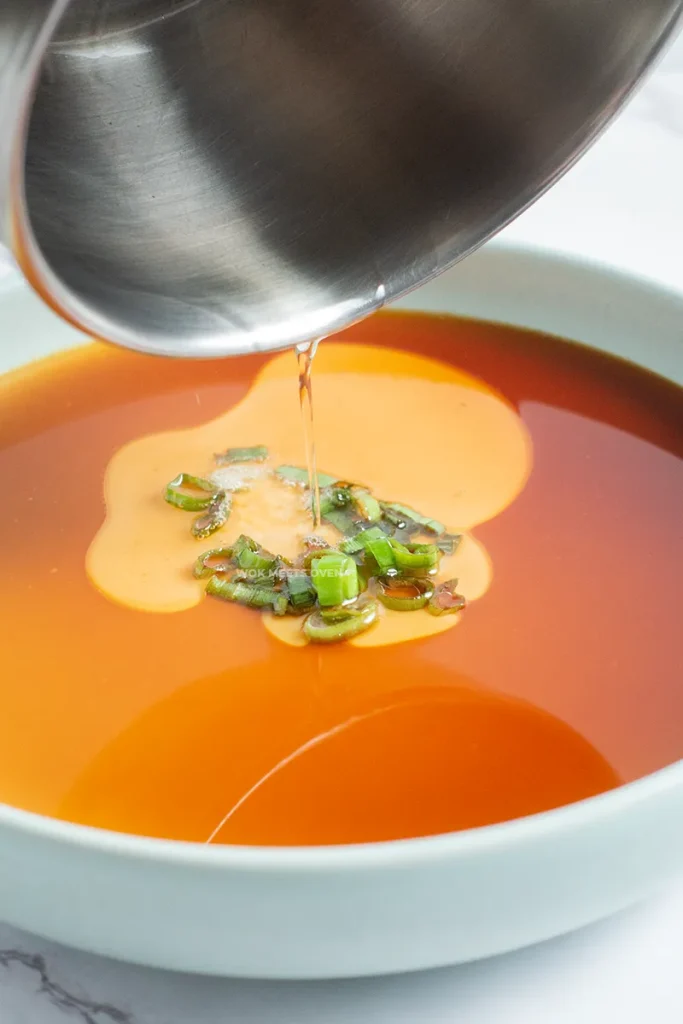
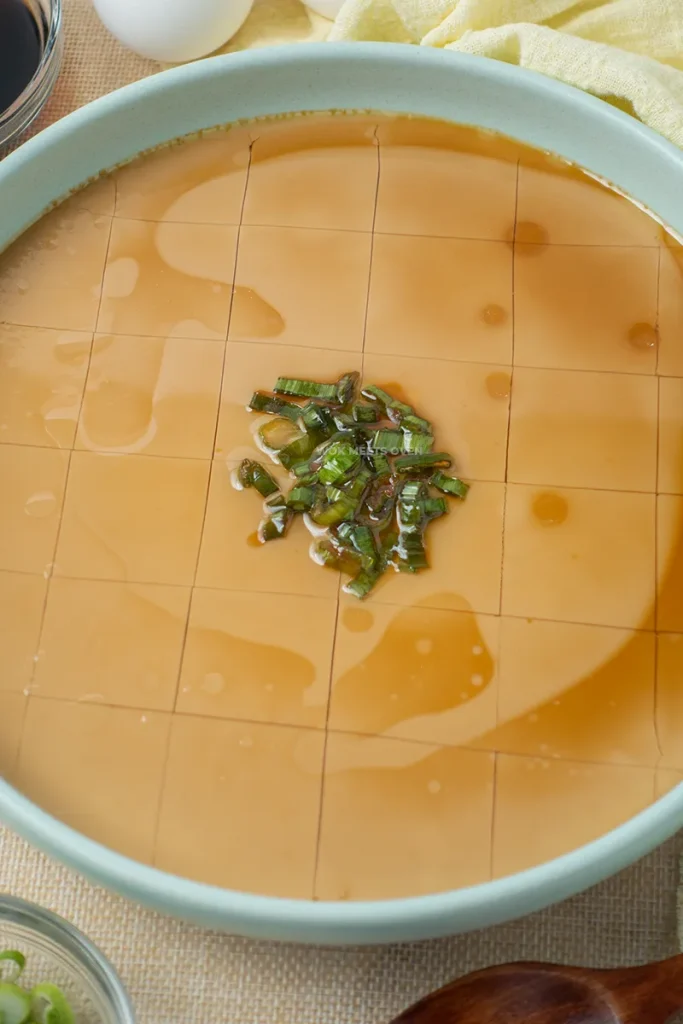
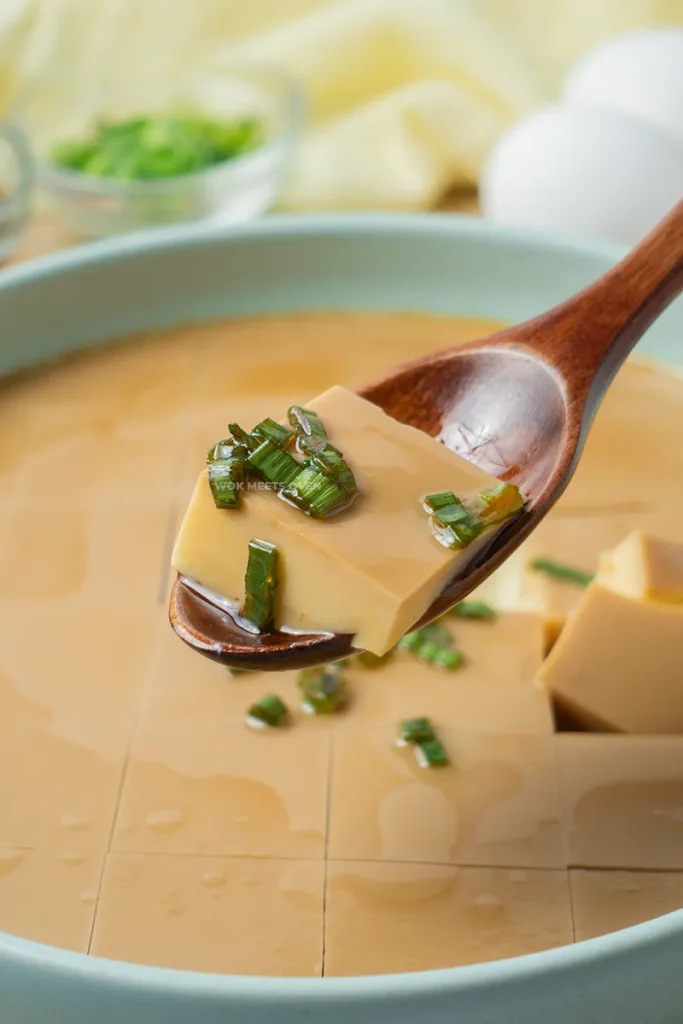
Tips
- Use distilled/boiled water (at room temperature) for this silky steamed egg recipe. Do not use tap water as it will add bubbles to the eggs and also affect the texture.
- Don’t overbeat your eggs while whisking them to avoid introducing too much air into the eggs. You should mix it well enough so that all of the ingredients are mixed well together, but don’t go overboard with it.
- Use heat-resistant plastic wrap, aluminum foil, or a plate on top (if you don’t like plastic/aluminum) to cover the bowl or plate of water eggs. This will help prevent water from dripping into your eggs while steaming them.
- Use a lighter or a toothpick to pop any bubbles that you see on the surface. For the very tiny bubbles on the edges, you can also use a spoon to scoop the bubbles out. This will ensure that your steamed eggs have a nice, smooth surface after steaming.
- You can check and see whether or not your eggs are done steaming by gently shaking the bowl or plate and seeing if the eggs wiggle a lot or if they are set inside the steamer. If the eggs are still very runny and wiggling a lot, you will need to steam them for a little longer. If the eggs have a slight wiggle to them in the center or they have set, then your eggs are done.
- If you see your eggs start to expand and rise up, that means your steaming temperature is too hot, and you’ll need to reduce the cooking temperature.
- Different thicknesses in bowls and plates will affect the steaming time. A thin bowl or plate will require less steaming time, while a thicker one will require more steaming time. The steaming time provided is just a guideline, and you may need to adjust based on the thickness of your own dinnerware. You can check and see if your eggs are done by gently shaking the plate and bowl and seeing if the eggs wiggle or not.
Common Mistakes Beginners Make
- Not pouring the water egg mixture through a sieve, causing excessive air bubbles and impurities to form on the steamed eggs after steaming
- Steaming the eggs for too long or using too high a temperature to steam them causes the eggs to overcook, dry out, and develop a lot of air bubbles inside the steamed eggs. It is better to slightly undercook the eggs than overcook them, as the eggs will continue cooking after shutting off the stove.
Chinese Steamed Eggs Storage Tips
The steamed water eggs can be stored in an airtight container for up to 5 days in the fridge.
How Do I Reheat the Steamed Eggs?
You can reheat this Chinese steamed egg dish in your microwave or use a steamer. Do not go overboard with the microwave when reheating the eggs, otherwise, they will dry out.
Likewise, when reheating the eggs using a steamer, don’t steam them for too long and steam using low to medium-low heat.
What to Serve With Chinese Steamed Eggs
This Cantonese steamed eggs recipe goes great with cooked white rice and some vegetable side dishes, such as Chinese broccoli with oyster sauce or other Chinese classics like Chinese eggplant with ground pork.
Frequently Asked Questions (FAQs)
Can I Add Additional Condiments and Toppings to the Steamed Eggs?
Yes!
Condiments such as chili oil and sesame oil work well with steamed eggs.
As for the toppings, you can try adding marinated ground pork, ground beef, or chicken on top.
Slices of pork and beef also work well with steamed eggs.
In addition, shrimp and fried shallots also taste good with steamed eggs.
Why Are There a Lot of Bubbles Inside My Eggs, and Why Are My Eggs Not Smooth?
There are a few factors that affect how smooth your eggs will turn out:
- Whether or not you have poured the eggs through a sieve to strain out the impurities. Failure to strain out the eggs will introduce a lot of air and bubbles into the eggs.
- Whether or not you used distilled warm, or room temperature water. Do not use tap water for this recipe!
- The temperature that you use to steam your eggs and how long you steam them for. A very high temperature causes the eggs to develop bubbles in the center, while steaming them for too long will also overcook the eggs. You want the eggs to be either just fully cooked or slightly undercooked. This way the eggs will still remain smooth after steaming them.
How Do I Tell When My Steamed Eggs Are Done?
Gently shake the bowl or plate and see if your eggs wiggle or not. If you notice that they are wiggling a lot, then they aren’t done yet. The eggs should only slightly wiggle in the center or not wiggle at all.
Why Are My Eggs Rising and Expanding While Steaming?
Your steaming temperature is too high, and/or you’re steaming the eggs for too long. Reduce the steaming temperature and also reduce the steaming time to prevent this from happening.
What Ratio of Water to Eggs Do I Use?
In this recipe, I use a 1:1.5 ratio of eggs to water. So that means if your eggs weigh, for example, 60g, then you will need 90 ml of water.
How Long Should I Steam My Chinese Steamed Eggs For?
As a general guideline, I recommend steaming the eggs for around 13-14 minutes on medium-low heat. I used a medium-thickness large bowl while making my eggs.
However, this time will vary depending on the temperature of your stove and how thick your bowl or plate is, which is why I suggest checking the eggs for doneness after they are done steaming by gently shaking the bowl or plate and seeing whether or not the eggs wiggle around.
The eggs should only slightly wiggle in the center or not wiggle much at all.
Other Recipes You’ll Love
- Chinese Steamed Egg Pudding Dessert
- Chinese Green Beans With Minced Pork
- Hakka Style Chinese Stuffed Tofu With Minced Pork and Shrimp
- Bok Choy Stir Fry
You can pin this image
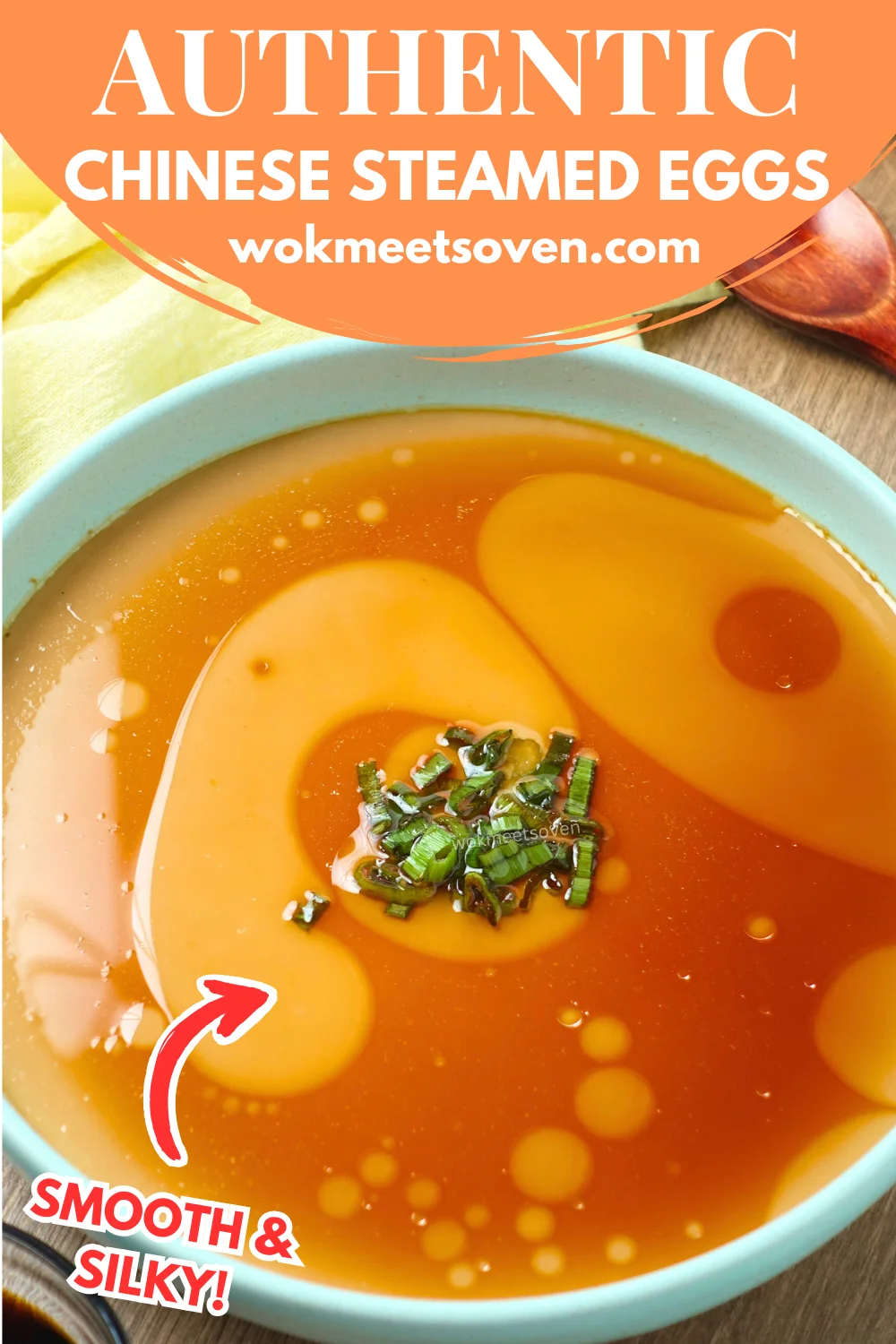
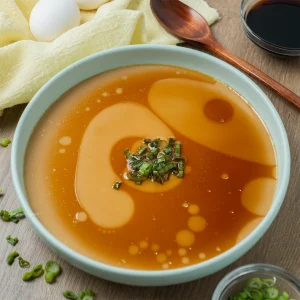
The Chinese Steamed Egg Recipe You’ll Want to Make Again and Again!
Equipment
- 1 Steamer or Wok
Ingredients
- 4 Large Eggs Room temperature
- 1/2 Teaspoon Table salt
- 360 ml Distilled water Or 1.5x weight of eggs in shell
- 2 Tablespoons Light soy sauce
- 1/2 Tablespoon White granulated sugar
- 1 Tablespoon Cooking oil
- 1 Green onion
Instructions
- Crack 4 eggs into a bowl. Add in your table salt and then whisk the eggs until they are thoroughly mixed.
- Now add the distilled water to the eggs and mix everything well together.
- Now, using a sieve, pour the egg water mixture into a large bowl or plate.
- If you see any bubbles, pop the bubbles by using either a toothpick or a lighter. You can also use a spoon to scoop out the bubbles. If you don’t pop the bubbles, then the surface of the eggs won’t look nearly as smooth.
- Next, cover the bowl or plate with some heat-resistant plastic wrap. Poke a few holes in the plastic wrap to let steam escape while steaming the eggs.
- Now add your eggs into a steamer or use a wok with a hot pot stand. Add some water to the wok or steamer and cover it with a lid, and bring it to a boil on medium heat.
- Once the water starts to boil, reduce the heat to medium-low and steam it for 13-14 minutes.
- While your eggs are steaming, prepare the soy sauce.
- In a small saucepan, add in your light soy sauce and sugar and mix everything well together. Heat up the saucepan until the sugar is melted, and then set it aside.
- Once 13-14 minutes have passed, turn off the stove but leave the eggs in the steamer or wok for another 5 minutes. Don’t open the lid!
- Finally, remove the eggs from the steamer after 5 minutes. Pour the soy sauce on top.
- Garnish the eggs with some green onions. Now heat up some cooking oil until it’s hot and then pour it on top of the eggs and green onions and serve.

